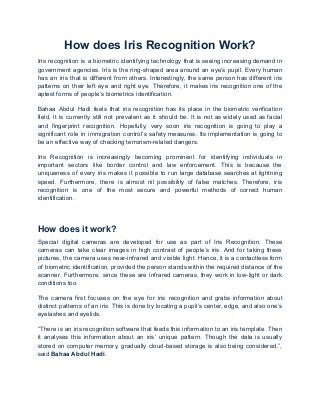How does Iris Recognition Work.pdf
Iris recognition is a biometric identifying technology that is seeing increasing demand in government agencies. Iris is the ring-shaped area around an eye’s pupil. Every human has an iris that is different from others. Interestingly, the same person has different iris patterns on their left eye and right eye. Therefore, it makes iris recognition one of the aptest forms of people’s biometrics identification. Bahaa Abdul Hadi feels that iris recognition has its place in the biometric verification field, it is currently still not prevalent as it should be. It is not as widely used as facial and fingerprint recognition. Hopefully, very soon iris recognition is going to play a significant role in immigration control’s safety measures. Its implementation is going to be an effective way of checking terrorism-related dangers.

Recommended
Recommended
More Related Content
More from Bahaa Abdulhadi
More from Bahaa Abdulhadi (20)
How does Iris Recognition Work.pdf
- 1. How does Iris Recognition Work? Iris recognition is a biometric identifying technology that is seeing increasing demand in government agencies. Iris is the ring-shaped area around an eye’s pupil. Every human has an iris that is different from others. Interestingly, the same person has different iris patterns on their left eye and right eye. Therefore, it makes iris recognition one of the aptest forms of people’s biometrics identification. Bahaa Abdul Hadi feels that iris recognition has its place in the biometric verification field, it is currently still not prevalent as it should be. It is not as widely used as facial and fingerprint recognition. Hopefully, very soon iris recognition is going to play a significant role in immigration control’s safety measures. Its implementation is going to be an effective way of checking terrorism-related dangers. Iris Recognition is increasingly becoming prominent for identifying individuals in important sectors like border control and law enforcement. This is because the uniqueness of every iris makes it possible to run large database searches at lightning speed. Furthermore, there is almost nil possibility of false matches. Therefore, iris recognition is one of the most secure and powerful methods of correct human identification. How does it work? Special digital cameras are developed for use as part of Iris Recognition. These cameras can take clear images in high contrast of people’s iris. And for taking these pictures, the camera uses near-infrared and visible light. Hence, it is a contactless form of biometric identification, provided the person stands within the required distance of the scanner. Furthermore, since these are infrared cameras, they work in low-light or dark conditions too. The camera first focuses on the eye for iris recognition and grabs information about distinct patterns of an iris. This is done by locating a pupil’s center, edge, and also one’s eyelashes and eyelids. “There is an iris recognition software that feeds this information to an iris template. Then it analyses this information about an iris’ unique pattern. Though the data is usually stored on computer memory, gradually cloud-based storage is also being considered.”, said Bahaa Abdul Hadi.
- 2. Iris recognition will work for any person with an iris. It can be used for identification for anyone who wears spectacles or contact lenses, and even a blind person too, Therefore, this technology is exceptionally handy in safe biometric identification. Only thing is, the scanner placement should be correct. There should not be any reflection for people using spectacles or contact lenses. It can accurately identify people in almost 99% of cases. Thank you for your time and for more articles from Bahaa Abdul Hadi, Please visit www.bahaaabdulhadi.com
